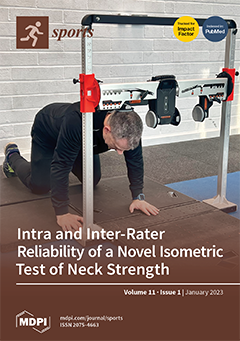To examine relationships between Brazilian Jiu Jitsu (BJJ) descriptors (belt rank, experience, gi preference, and fighting style), resistance training (RT) experience, and measures of body composition, strength (maximal handgrip, 3-5-repetition maximum [RM] in barbell glute bridge [GB], prone bench row [PBR], and bench
[...] Read more.
To examine relationships between Brazilian Jiu Jitsu (BJJ) descriptors (belt rank, experience, gi preference, and fighting style), resistance training (RT) experience, and measures of body composition, strength (maximal handgrip, 3-5-repetition maximum [RM] in barbell glute bridge [GB], prone bench row [PBR], and bench press [BP]), and velocity (GB, PBR, and BP at 7 kg and 30–60% 1-RM), 13 experienced (4.3 ± 3.4 years) BJJ athletes were recruited for this cross-sectional, pilot study. Significant (
p < 0.05) Kendall’s tau and Bayesian relationships were seen between belt rank and body fat percentage (τ = −0.53, BF
10 = 6.5), BJJ experience and body fat percentage (τ = −0.44 to −0.66, BF
10 = 2.6–30.8) and GB velocity (τ = −0.45 to −0.46, BF
10 = 2.8–3.1), RT experience and strength (τ = 0.44 to 0.73, BF
10 = 2.6–75.1) and velocity (τ = −0.44 to 0.47, BF
10 = 2.6–3.3), gi preference-training and relative PBR strength (τ = 0.70, BF
10 = 51.9), gi preference-competition and height and lean mass (τ = −0.57 to 0.67, BF
10 = 5.3–12.4) and BP velocity (τ = −0.52 to 0.67, BF
10 = 3.5–14.0). The relevance of body composition and performance measures to sport-specific training and research interpretation are differentially affected by a BJJ athlete’s experience (BJJ, belt rank, RT), gi preferences, and fighting style.
Full article






